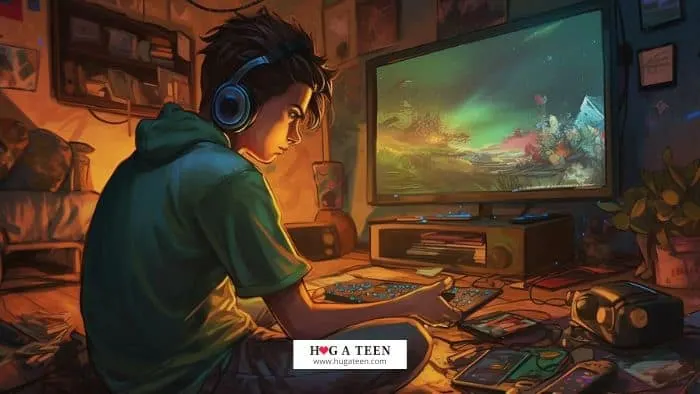While gaming can have its benefits, it is important to recognize that excessive gameplay can lead to negative impacts on physical health, mental well-being, and social activity.
Determining how much video game playing is too much for teens involves considering various factors, including age, maturity, the type of game being played, and who they are playing with.
Finding the right balance is key when it comes to teens and video game playing. By implementing strategies and interventions, parents can help prevent excessive gaming and safeguard their teens’ physical health, mental well-being, and social development.
- What is Excessive Gaming?
- How Many Hours of Video Games Is Too Much For Teens?
- Warning Signs of a Problematic Gaming Disorder In Teens
- How To Determine If It's A Problem
- Factors Affecting How Much Gaming Is Too Much?
- Negative Effects of Excessive Gaming
- How Parents Can Help Prevent Teenage Video Game Addiction
- Research & Studies on Excessive Gaming in Teens
- Why does my kid want to watch other people play video games?
What is Excessive Gaming?

Excessive gaming refers to the behavior of spending an excessive amount of time engaged in video game playing to the extent that it starts to negatively impact various aspects of a teenager’s life.
It is characterized by impaired control over gaming habits, prioritizing gaming over other activities, and continuing to game despite experiencing negative consequences.
This behavior can have detrimental effects on physical health, as excessive gaming often leads to a sedentary lifestyle, resulting in a lack of physical activity. This can contribute to issues such as obesity, poor cardiovascular health, and even eye strain.
Mental health is also affected by excessive gaming. Prolonged gaming can lead to sleep deprivation, affecting a teenager’s cognitive functioning, mood, and overall mental well-being. It can also result in poor school performance due to decreased focus and concentration.
Excessive gaming can also hinder social activity. As teenagers spend more time in virtual worlds, they may withdraw from real-life interactions and activities, leading to social isolation and difficulty in forming and maintaining relationships.
Furthermore, excessive gaming can be considered a form of addiction. Internet addiction follows similar patterns as substance addiction, with individuals experiencing cravings, withdrawal symptoms, and an inability to control or moderate their gaming habits.
It is crucial to address excessive gaming in teenagers as it can have significant implications for their overall well-being. Encouraging moderation, setting limits, and promoting a healthy balance between gaming and other activities is essential to ensure their physical, mental, and social development.
👍 Suggested reading Driving Games For Teens To Learn How To Drive
How Many Hours of Video Games Is Too Much For Teens?

Although many studies have shown that excessive screen time can have a negative impact on physical, mental, and social well-being, there is no consensus on how much video game time (and general screen time) is too much.
Some studies suggest that between 1 to 3 hours a day is acceptable, while others agree that there are several factors that need to be taken into account, such as their age and the type of games they’re playing.
The American Academy of Pediatrics suggests time allotted should be under 30 to 60 minutes per day on school days and 2 hours or less on non-school days.
Twenge and her colleagues concluded that more than five hours per day is deemed excessive and may lead to an increase in depressive symptoms, suicide-related outcomes, and suicide rates among U.S. adolescents. More than five hours a day also interferes with how much sleep a child or teen gets per night, how much time they spend doing homework, and how much time they have for physical activity.
Warning Signs of a Problematic Gaming Disorder In Teens

It is important to be aware of the warning signs that may indicate a problematic gaming disorder in teenagers. Some common symptoms include:
1. Poor performance in school: Excessive gaming can interfere with a teenager’s academic performance. They may struggle to concentrate in class, complete homework assignments, or study effectively.
2. Irritability when forced to stop gaming: If a teenager becomes extremely irritable or agitated when asked to stop gaming, it could be a sign of dependency or addiction.
3. Neglecting personal hygiene: Teens with a gaming disorder may neglect their personal hygiene, skipping showers or neglecting basic self-care tasks because they prioritize gaming over taking care of themselves.
4. Neglecting relationships: Excessive gaming can lead to a withdrawal from real-life relationships. Teens may show a lack of interest in spending time with family or friends, isolating themselves to focus solely on gaming.
5. Inability to control gaming time: An inability to control or limit gaming time, even when faced with negative consequences, is a clear warning sign of gaming addiction.
6. Aggressive behavior: Excessive gaming has been linked to aggressive behavior in teens, especially when playing violent video games.
Recognizing these warning signs is crucial in addressing and seeking help for problematic gaming behavior in teenagers. Early intervention and support can prevent further negative impacts on their academic, social, and emotional well-being.
❤️You might also be interested in reading about the Understanding Different Parenting Styles
How To Determine If It’s A Problem

Determining whether excessive gaming is becoming a problem for teenagers can be challenging but crucial for their well-being. By recognizing warning signs and asking the right questions, we can gain insight into their gaming habits and potential issues.
1. Notice The Warning Signs
It’s important to be aware of warning signs such as poor performance in school, neglecting personal hygiene, and irritability when asked to stop gaming. If a teenager is consistently struggling academically, neglecting self-care tasks, or becoming easily agitated when gaming is interrupted, it may indicate a problematic gaming disorder.
2. Withdrawal From Social Interactions
Consider the impact on relationships, school, and hobbies. Excessive gaming can lead to a withdrawal from real-life connections and neglect of other activities. If a teenager shows little interest in spending time with family or friends, and their hobbies or schoolwork suffer, it may be a sign that gaming is interfering with their life balance.
3. Consider Hours Spent
Additionally, the amount of time spent gaming is worth considering. Spending eight to 10 hours a day or at least 30 hours a week playing video games is a significant investment of time. Such an extensive commitment to gaming may indicate an unhealthy level of dependency and potential gaming disorder.
4. Assess Physical and Mental Health
Excessive gaming can contribute to problems such as sleep deprivation, sedentary behavior, and even mental health concerns. If a teenager experiences physical discomfort, declines in overall well-being, or demonstrates signs of addictive behavior related to gaming, it’s important to address these issues.
5. Change In Behavior
Parents should keep a close eye on their child’s behavior. Spending too much time gaming could make a teen more moody, grumpy, and even aggressive. Any negative change in behavior could be a warning sign.
❤️ Suggested reading: Psychological Impact Of Different Parenting Styles On Teens
Factors Affecting How Much Gaming Is Too Much?

1. Age and maturity matter
When it comes to determining how much video game time is appropriate for teenagers, age and maturity both play a crucial role. The American Psychological Association (APA) recognizes the significance of this and provides valuable guidelines for parents and educators. These guidelines suggest establishing consistent limits and monitoring the types of media children are exposed to from the age of six onwards.
Older teenagers may handle longer gaming sessions differently than younger children, which is why their age should be considered when setting boundaries. While younger children might require shorter gaming sessions to prevent overstimulation, older teenagers might have better self-regulation and be able to handle longer gaming sessions more responsibly.
Age and maturity influence how teenagers respond to video games and their ability to balance screen time with other important activities such as physical exercise, social interaction, and school performance.
By taking these factors into account, parents can help ensure that their teenagers are engaging in a healthy balance of activities. It is important to monitor and guide teenagers in their gaming habits to prevent any negative consequences related to excessive gaming or neglect of other important aspects of life.
2. Who are they playing with?
When it comes to teens and video games, it’s not just the amount of time they spend playing that matters, but who they are playing with. While playing alone can provide a sense of independence and autonomy, it is important for teenagers to also engage in social interaction during gaming sessions.
Playing video games with others can have several benefits, including promoting healthy habits and preventing excessive gaming. When teens play with friends or family members, it encourages social interaction and strengthens relationships. This can help balance their gaming time with other important activities, such as physical exercise and face-to-face communication.
On the other hand, excessive solo gaming can lead to unhealthy habits. Spending too much time gaming alone may result in social isolation and a neglect of real-life relationships. It is important for parents to ensure that their teenagers have a healthy balance between solo gaming and social interaction with peers.
3. What game are they playing?
When determining the impact of excessive gaming in teens, it is important to consider various factors, including the quality of the game being played and the type of activities involved. The game’s quality can influence the amount of time spent on gaming.
Engaging games that encourage creativity, problem-solving, and critical thinking may captivate teens for longer durations. On the other hand, repetitive or mindless games may lead to shorter gaming sessions.
Parents and guardians should suggest a variety of games to their teens. Introducing them to different genres, such as strategy, adventure, or puzzle games, can help prevent monotony and excessive gaming. By exploring various options, teens can discover new interests and engage in diverse gaming experiences.
Negative Effects of Excessive Gaming

1. Impact on Physical Health
Excessive gaming can have a significant impact on the physical health of teens. One consequence is sleep problems, as gaming late into the night can disrupt sleep patterns. The intense stimulation and excitement from gaming can make it difficult for teens to wind down and fall asleep, leading to sleep deprivation and fatigue.
Another health concern associated with excessive gaming is obesity. Spending excessive hours gaming means less time for physical activity. Teens who spend long periods sitting and playing video games are at a higher risk of developing sedentary lifestyle habits, which can contribute to weight gain and obesity. Lack of physical activity not only affects weight but can also negatively impact cardiovascular health and overall fitness levels.
Constant screen glare from video games can also harm eyesight. Prolonged exposure to screens can lead to eye strain, dryness, and discomfort. This can be particularly concerning for teens whose eyes are still developing.
2. Impact on Mental Health
Excessive gaming not only takes a toll on physical health but also has a significant impact on the mental well-being of teenagers. Video game addiction can be linked to various mental health conditions, amplifying existing issues and even giving rise to new ones.
One prominent mental health concern associated with excessive gaming is anxiety. Teens who spend an excessive amount of time gaming may experience heightened levels of anxiety, arising from the pressure to meet in-game targets or the fear of missing out on gaming-related activities.
Depression is another common issue that may arise from excessive gaming. Isolation, social withdrawal, and a lack of engagement in real-life activities can contribute to feelings of sadness and lead to depressive symptoms.
Moreover, gaming addiction has been linked to the development of gambling behaviors in teens. The in-game transactions and loot boxes within some games may normalize gambling-like behavior, leading to risky financial habits and negative consequences in real life.
Additionally, excessive gaming can worsen symptoms of attention-deficit/hyperactivity disorder (ADHD) in those who already struggle with it.
3. Impact on Social Activity and Real Life Performance
Excessive gaming can have a significant impact on social activity and real-life performance in teenagers. One of the primary concerns is the withdrawal from social interactions that often accompanies excessive gaming.
Spending excessive amounts of time gaming can lead to a decline in face-to-face communication and a lack of engagement in social activities with family and friends. This withdrawal from social interactions can negatively affect the development of important social skills and lead to feelings of isolation and loneliness.
Furthermore, excessive gaming can also have detrimental effects on academic performance. As teenagers spend more time gaming, their focus and dedication toward schoolwork may diminish. This can lead to a decline in grades, decreased productivity, and poor time management skills.
It is not uncommon for excessive gamers to neglect their responsibilities and prioritize gaming over important tasks such as homework, studying, or participating in extracurricular activities.
How Parents Can Help Prevent Teenage Video Game Addiction
As technology continues to evolve, video games have become an increasingly popular form of entertainment for teenagers. While gaming in moderation can offer certain benefits, it is essential for parents to be aware of the potential risks of excessive gaming and take proactive steps to prevent video game addiction in their teenagers.
By educating themselves about the negative impacts of excessive gaming and implementing effective strategies, parents can play a crucial role in helping their teens develop a healthy and balanced relationship with video games.
1. Establish Clear Time Limits and Boundaries
One of the most important ways parents can help prevent teenage video game addiction is by establishing clear time limits and boundaries. Set specific rules regarding how much time can be spent gaming each day and enforce them consistently.
It is also important to establish designated times for video game play, such as after completing homework or chores. By doing so, parents can ensure that gaming remains a recreational activity and does not become all-consuming.
2. Encourage Alternative Activities
Encouraging teenagers to engage in alternative activities beyond gaming is another effective strategy. Encourage participation in physical activities, such as sports or outdoor play, to promote physical health and reduce sedentary behavior.
Encourage social activities, such as spending time with friends, joining clubs or organizations, or pursuing hobbies and interests. By offering a variety of stimulating and fulfilling activities, parents can help divert their teenagers’ attention from excessive gaming and promote a more balanced lifestyle.
3. Open Communication and Monitoring
Maintaining open communication with teenagers about their gaming habits is essential. Talk to them about the potential negative consequences of excessive gaming, including impacts on academic performance, social relationships, and overall well-being.
Encourage them to share their experiences and concerns and be supportive rather than judgmental.
Additionally, consider using parental controls and monitoring software to track and limit the amount of time spent gaming. This can help parents identify any potential signs of addiction and address them early on.
4. Parental Controls and Time Limits
Parental controls and time limits are crucial tools for managing teen gaming and ensuring a healthy balance between virtual and real-life activities. By utilizing these features, parents can have more control over their child’s gaming habits and protect them from the potential negative impacts of excessive gameplay.
Parental controls allow parents to set limits on game time, effectively restricting access to certain games or content that may not be appropriate for their teenager. This feature enables parents to customize the gaming experience based on their child’s age, maturity level, and personal preferences. By setting reasonable time limits and gradually reducing gameplay hours, parents can effectively manage gaming and encourage alternative activities.
It is important for parents to lead by example and keep their own devices away during designated non-gaming times. This sets a positive tone and reinforces the message that technology should not dominate one’s life. Moreover, parents should actively engage in discussions with their teenagers about the importance of a balanced lifestyle and the potential negative consequences of excessive gaming.
Monitoring gaming activity is another aspect of parental controls that can provide valuable insights into a teenager’s gaming habits. By keeping track of gaming sessions, parents can identify any patterns of excessive gameplay and address potential issues promptly.
It is recommended that parents set gaming time limits for their teens. A general guideline is to limit gaming to no more than 30 hours per week. If a teenager consistently exceeds this limit, it can be considered a red flag. Additionally, if a teen is gaming for more than 70 hours per week, it is a clear sign of a problem that needs to be addressed.
🤓 Suggested reading: Positive Effects Of Video Games On Teenagers
5. Give them a warning
Giving teens a warning about excessive video game playing is crucial in order to help them maintain a healthy balance between gaming and other activities. Teens often become engrossed in their gameplay and lose track of time, which can negatively impact their physical and mental well-being. By providing a gentle warning to teens, parents can help ease the transition and encourage them to set appropriate limits.
One strategy that can aid in the transition is cognitive priming. This involves giving teens a set amount of time to finish their current level or communicate with their peers before taking a break. By giving them a clear time frame, it allows them to mentally prepare for the end of their gaming session and transition to other activities.
6. Suggest a transition task
Suggest a transition task that can help teenagers move away from excessive gaming and engage in other activities. One effective transition task is to encourage teenagers to set goals for themselves within the game they are playing. For example, they can set a goal to complete a certain number of levels or achieve a specific milestone before taking a break. This can help them feel a sense of accomplishment and closure before moving on to other activities.
It is important to offer appealing options for teenagers to engage in after their gaming sessions. This can include activities such as going for a walk, playing a sport, or pursuing a hobby. By providing enjoyable and fulfilling alternatives, teenagers will be more motivated to transition away from gaming.
Encouraging physical activity as a transition task can be particularly beneficial. Engaging in activities like walking the dog or going for a swim triggers the release of positive neurotransmitters such as endorphins, which can improve mood and overall well-being. This can help shift the focus away from gaming and promote a healthier balance of activities in a teenager’s life.
7. Be consistent in your messaging
Being consistent in your messaging when addressing video game limits with your teen is crucial for establishing clear expectations and preventing confusion or loopholes. Consistency helps create a structured environment where both parents and teenagers understand the rules and consequences.
One effective strategy is setting specific guidelines for video game usage. Clearly communicate the amount of time your teen is allowed to spend gaming each day or week. This not only sets a clear boundary but also helps your teen understand what is expected of them.
Discussing the potential outcomes of adhering to or disregarding the limits is another important step. Explain how excessive gaming can negatively impact their mental and physical health, as well as their school performance and social life. By having open conversations about these potential consequences, your teen will have a better understanding of why the limits are in place.
However, consistency is not just about setting rules and discussing outcomes; it is also about following through with consequences. If your teen exceeds the agreed-upon gaming time, it is important to enforce the consequences that were previously discussed. This demonstrates the importance of sticking to the established limits and helps your teen understand that there are real consequences for their actions.
9. Seek professional help if necessary
If parents notice signs of excessive gaming and potential addiction, it is important not to hesitate in seeking professional help. This can involve consulting with a mental health professional who specializes in behavioral addictions or gaming disorders. They can provide valuable guidance, assess the severity of the situation, and recommend appropriate interventions or treatments, such as behavioral therapy.
In addition to targeting gaming behaviors, therapists in behavioral therapy and counseling also help teens recognize and address underlying mental health issues that may contribute to excessive gaming.
Many teens turn to gaming as a way to cope with stress, anxiety, or depression. By providing a safe and supportive space, therapists can help teens explore and address these underlying issues, giving them healthier alternatives to gaming as a form of escape or coping mechanism.
Research & Studies on Excessive Gaming in Teens
Research and studies have shed light on the issue of excessive gaming in teens, highlighting the various negative impacts it can have on their mental and physical well-being.
Several studies have shown a correlation between excessive gaming and problems such as decreased academic performance, sleep deprivation, social isolation, and even aggressive behavior.
According to the Mott Poll Study, 86% of parents believe that teens spend too much time playing video games. This excessive gaming can lead to negative consequences such as sleep deprivation, poor school performance, and reduced physical activity. The study also revealed that 61% of parents reported that their teenagers’ video game playing interfered with real-life social activities.
Furthermore, the Mott Poll found that excessive gaming can also impact mental health. Teens who spend more than three hours a day playing video games were more likely to experience higher levels of psychological distress.
Another study published in the journal JAMA Pediatrics found that excessive video game playing is associated with an increased risk of developing attention problems in teenagers. These findings emphasize the importance of addressing excessive gaming habits in teens and implementing strategies to promote healthier choices and balanced lifestyles.
Why does my kid want to watch other people play video games?
Have you ever wondered why your child or teen is so interested in watching other people play video games? It may seem puzzling at first, but there are several reasons why this trend has become so popular.
One of the main reasons is the social aspect. Livestreams of video games provide an opportunity for kids and teens to connect and interact with others who share the same interests. They can chat with the streamer and fellow viewers, forming a sense of community and belonging.
Another factor is the learning aspect. Watching skilled players navigate through games can be educational. Young gamers can pick up strategies, tips, and tricks to improve their own gaming skills. It’s like having a virtual mentor that they can learn from.
Entertainment is also a significant factor. Just like watching a favorite TV show or movie, spectating video games can be entertaining. It’s often filled with excitement, funny moments, and unexpected outcomes, keeping viewers hooked and invested in the gameplay.
Lastly, watching others play video games can offer an escape from reality. It allows kids and teens to immerse themselves in a different world, experiencing stories and adventures that they may not be able to participate in themselves.
While there are benefits to watching live streams, it’s important to be aware of the potential risks. Kids and teens may be exposed to inappropriate content or encounter cyberbullying, so it’s crucial to monitor what they are watching and who they are interacting with online.
In conclusion, the social, learning, entertainment, and escapism aspects are what draw kids and teens to watch others play video games. By understanding these motivations and monitoring their online activities, we can ensure a safe and enjoyable experience for our children.
